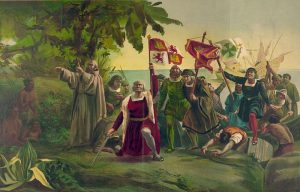Readings
In 1492, Columbus Sailed the Ocean Blue…


In his journals Columbus described the new lands in front of him “as being very flat”; he wrote that “the land was ideal for cultivation, covered with trees right down to the rivers… [He was amazed how]… these trees were lovely and green and each bore its own fruit or flower.”
Columbus commented that there were many birds, large and small, which sung sweetly, and “… there were a great number of palms of moderate height and the Indians covered their houses with them.”
Like Columbus, early chroniclers often expressed their amazement of the whole Caribbean region, which they praised for being a stand of precious wood—mahogany, cedar, ebony, in whose shade, they insisted, one could walk from one end of the island to the other.
Columbus accounts of the vast forests of the Americas is more than a historical fact, this retelling of what Columbus and those that came after him saw reveals the importance of forests within the grand story of Spanish colonialism. The exploitation of these forests would within a few years of Columbus’ writing require the forced displacement of global populations– the removal of indigenous populations from their ancestral lands, and within less than a century, the forced transport of enslaved labor required to clear the forests to make way for agriculture.
The writings of early Spanish settlers are worthwhile because they reveal what aspects of the “discovery” were important, and why. The writings provide great detail about the terrain and a people, (such as the abundance of trees the Native population), the flatness of the land and the variety of birds, and importantly the much desired ability to move about and to walk freely. As per the writings of Columbus he was impressed by the ability to walk in the shade of ancient trees from one end of the island to the other. The communication of an abundant amount of precious forests and space to walk would prove to be so important as to inspire many to cross the Atlantic Ocean and occupy the Caribbean.
Columbus’ focus on the forests of the Americans speaks volumes about the loss of the vast forests in Europe. The mention of these natural resources and descriptions of a docile Native population were noteworthy to Columbus, and of even greater interest to the King of Spain?
Food for thought…
Giving attention to the environmental history of Spanish colonialism allows for different questions to be asked: For example, the story of Spanish colonization tends to center the desire for gold, but how is that history enriched if the abundance of precious forests, which would have been of great value to the Spanish crown, is also incorporated? And, was the landscape of the Western Hemisphere altered by the growth of Spanish colonial agriculture, enslavement and other massive migrations across the Atlantic?
Other questions that arise include:
- What did the value of land mean for those doing the ‘discovering’?
- Why would the act of walking freely, underneath a canopy of trees. seem so special to merit it being listed as significant?
- Was the environment of settlers, by comparison, devoid of natural resources and constrained– thereby impeding ‘walking freely’?
- And, who or whom is it that would be granted the right to ‘walk freely’?
- Do we today walk freely through forests? Or, through our neighborhoods?
- What is it that remains of the vast forests Columbus described?
Attention to the land, the trees and the ability to walk allows us to consider the quality of the environment for those living without the trees 500 years after Columbus’ voyage.
If interested in exploring a sliver of the vast forests encountered by the Spanish please take a trip to the UCF Arboretum. Or, for a virtual reality tour of the Arboretum click on any of the links below.
Immerse yourself in the natural surroundings of UCF’s Aboretum through the following technologies:
- The web version – This website requires an internet connection.
- The augmented reality (AR) version – This AR experience requires iOS 11 or Android 7.0 or later.
- The virtual reality (VR) version – This VR experience requires Windows 10 (with a GeForce® GTX 1070 with 8GB GDDR5 and other requires—see website for more info).

